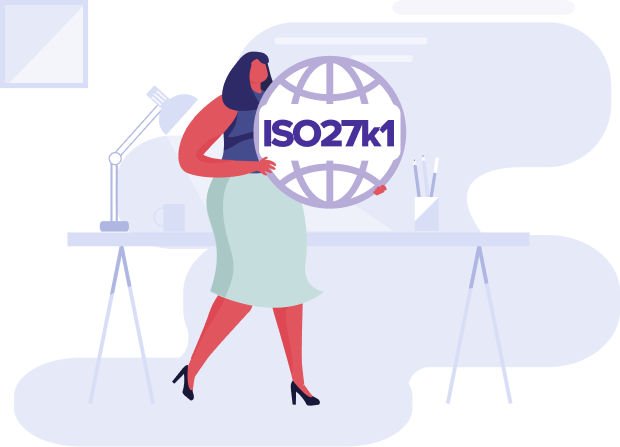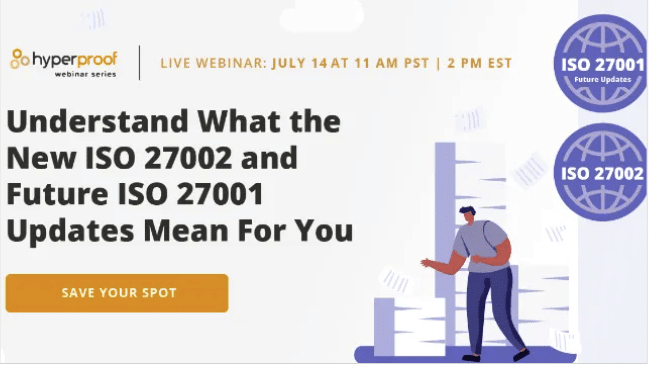Breaking Down SOC 2® and ISO 27001: Is One Really Better?
Author’s note: this piece was updated with fresh information in September 2021. It was originally published in March 2021.
We can all agree on the importance of protecting customer data today; 87% of consumers view data privacy as a human right, and 97% of U.S. consumers report that data privacy is a concern. Protecting customers’ sensitive information and demonstrating proof is non-negotiable for all businesses regardless of industry. Savvy B2B buyers will undoubtedly ask to see a SOC 2® report or an ISO 27001 certification, and those businesses unable to provide proof of compliance will struggle to compete. Related: Guide to ISO 27001
However, as a business looking to prove security commitment, you may wonder whether you’ll be better off getting a SOC 2® attestation report or an ISO 27001 certification. Which framework endorsement stamp has more clout? Is one really better than the other? Great questions—and in this article, we will compare the two frameworks, discuss the similarities and differences between them, and share some advice for organizations looking to go the extra mile in demonstrating their commitment to protecting customer data. Related: Guide to SOC 2®

ISO 27001 Overview
The ISO 27001: 2013 is the internationally recognized standard that outlines the requirements for constructing a risk-based framework to initiate, implement, maintain and manage information security within an organization. It can be used to manage the security of assets such as financial information, intellectual property, employee and customer details, and third-party entrusted information. Created by the International Standards Organization, ISO 27001 also defines what is an information security management system (ISMS), what is required to be included within the ISMS, and how management should form, monitor, and maintain the ISMS. ISO 27001 also comes with a control set for organizations to implement to address their information security risk, known as Annex A of ISO 27001.
An ISO 27001 certification, performed by an accredited certification body, is an independent validation that the ISMS conforms to the requirements of the ISO 27001 standard.
An issued certificate is valid for a three-year term, during which time surveillance audits must be completed. The ISO certificate is meant to communicate that the ISMS is actively implemented and continues to operate effectively.
Get to Know the ISO 27001 Standard and See What It Takes to Become ISO 27001 Certified

Organizations choose to get ISO 27001 certified because it signals to the market that the organization has invested significant time and resources in security and IT risk management.
Sidebar: Revisions to the control set of ISO 27001:2013 (Annex A of ISO 27001) are well underway. The draft was published in early 2021 and is available for purchase at the ISO Standards Store. It is expected to be published formally later in 2021—or early 2022 at the very latest. When the new version is in fact published, the 2013 version will be replaced and then canceled.
SOC 2® Overview
SOC (Service Organization Controls) is a set of standards created by the AICPA for assessing and rating the competency of an organization’s controls. SOC for Service Organizations: Trust Services Criteria—also known as SOC 2® Reports—are intended to meet the needs of a broad range of users that need detailed information and assurance about an organization’s controls relevant to the security, availability, and processing integrity of the systems the organization uses to process users’ data and the confidentiality and privacy of the information processed by these systems. These reports can play an important role in the oversight of the organization, vendor management programs, internal corporate governance, risk management processes, and regulatory oversight.
There are two types of SOC 2® reports: type 1 and type 2.
A SOC 2® Type 1 examination provides a point-in-time assessment of the data protection controls present in an organization. The design of the controls is assessed, and implementation is confirmed, but consistent performance is not evaluated in a Type 1 report. If an organization is new to SOC 2®, getting a SOC 2® Type 1 report is the first step.
A SOC 2® Type 2 examination covers the operating effectiveness of controls over a specific time, such as a six-to-12-month period. A SOC 2® Type 2 report is a higher bar than a Type 1 because in addition to evaluating the design and implementation of control processes, it also assesses whether the controls were consistently performed throughout the specified period. This provides a greater level of confidence in the effectiveness of control processes for customers and business partners.
Similarities Between SOC 2® and ISO 27001
These two security governance frameworks share many commonalities:
- Both provide independent assurance on the service organization’s controls that were designed and implemented to meet a specific set of requirements or criteria
- The frameworks share equally regarded and respected reputations and are accepted worldwide
- Clients view both as viable proof of your company’s ability to protect data. In short, having either a SOC 2® Type 2 report or ISO 27001 certification in hand will enhance your brand’s reputation and help you win new business.

Differences between SOC 2® and ISO 27001
The most significant difference between the frameworks comes down to attestation vs. certification. The SOC 2® attestation report is a detailed report outlining the controls that meet the applicable Trust Services Criteria based on the company’s principal service commitments and system requirements. A SOC 2® report should not be referenced as a “certification”. An ISO 27001 certification audit is conducted by an accredited assessment organization that measures whether an organization’s ISMS conforms against the “standard requirements” of the ISO 27001 framework.
Another significant difference is the time period covered by an examination. The ISO 27001 certification is a forward-looking three-year cycle while the SOC 2® examination covers either a point in time (in the case of a Type 1 report) or a period that occurred in the past (in the case of a Type 2 report).
The ISO 27001 certification does not provide the details of an organization’s environment or its related controls. The SOC 2® report provides the details regarding the controls and the environment that may be useful to customers.
For SOC 2®, an organization new to SOC 2® would start with a Type 1 assessment and then move on to annual Type 2 assessments. For ISO 27001, an organization would go through an initial certification audit—consisting of two stages—and go through surveillance audits in year 2 and year 3. After three years, an organization must go through a full recertification audit.
SOC 2® and ISO 27001 – comparison overview
Source: Schellman
| Audit Components/Area | SOC 2® | ISO 27001 |
| Who can perform the audit? | CPA firm | Accredited certification body |
| Independence Required | Yes | Yes |
| Internationally Accepted? | Yes | Yes |
| Objectives | Achievement of principal service commitments and system requirements based on the applicable trust services criteria | IMSM conformance to the requirements of the ISO 27001 standard |
| Criteria | AICPA Trust Services Criteria (Security, Availability, Confidentiality, Processing Integrity, and/or Privacy) | ISO 27001 standard (clauses 4-10 and Annex A controls) |
| Audit Type/Deliverable | Attestation examination/report | Certification |

SOC 2® vs. ISO 27001: Is one better?
This brings us back to our original query. Is one of the two security governance frameworks better than the other? Does one provide more advantages or carry more weight in security circles?
Well, the answer is—it depends on who you ask and their individual needs, so neither security framework is intrinsically superior.
When picking the proper security framework for you, the best advice is to look long and hard at your market, your customer’s preferences, and the regulatory requirements your business must comply with. We recommend getting both a SOC 2® Type 2 report and an ISO 27001 certification because if you obtain one, you’re well on your way to qualifying for the other. Meeting the requirements for both exhibits a heightened security posture and simplifies audits because of the many parallels between SOC 2® and ISO 27001.
How Hyperproof Supports SOC 2® and ISO 27001 Compliance
Both SOC 2® and ISO 27001 can provide excellent security frameworks to help your organization safeguard sensitive information and maintain customer trust while boosting its reputation. But meeting the requirements for each involves extensive documentation and creating auditable workflows, which can become an overwhelming task if your team isn’t prepared with an organized, systemic approach.
Now for some good news: Hyperproof’s security Compliance Operations software is designed to help businesses implement, maintain, and scale-up multiple security and privacy compliance programs. Security and compliance professionals from organizations of all sizes have leveraged Hyperproot to meet the requirements of both SOC 2® and ISO 27001.
Concerning SOC 2®, Hyperproof comes with a template that contains the AICPA Trust Services Criteria and illustrative controls that you can tailor to your specific environment. Hyperproof also makes it much easier to map your internal controls to SOC 2® requirements, collect and review evidence for audits, and collaborate remotely with staff and external advisors to get everything in order.
For ISO 27001, Hyperproof’s Compliance Operations software provides:
- A template containing ISO 27001 requirements and Annex A controls to help you start implementing an ISMS
- The ability to document context and or/scoping information about your ISMS
- The ability to maintain ISMS documentation and track activities across the clauses and activities with a single platform
- The ability to document and track identify risks maintain information security objectives and risk treatment plans within a single platform
- The ability to set up an internal audit program which includes the required steps for a company to audit its own ISMS and control activities
- Manage issues identified from internal and external audits and ensure remediation activities are completed
- The ability to build a common control framework that meets the needs of ISO 27001 Annex A control set as well as SOC 2® Trust Services criteria or any additional frameworks (e.g., ISO 27017, ISO 27018, ISO 27701, NIST SP 800-53, PCI DSS, etc.)
There you have it—the information and the partnership necessary to assist your team in selecting, implementing, and maintaining the proper security governance framework for your business. You owe it to your business and your customers to do everything possible to keep the information you handle safely in today’s ultra security-conscious world.
See Hyperproof in Action
Related Resources
Ready to see
Hyperproof in action?











